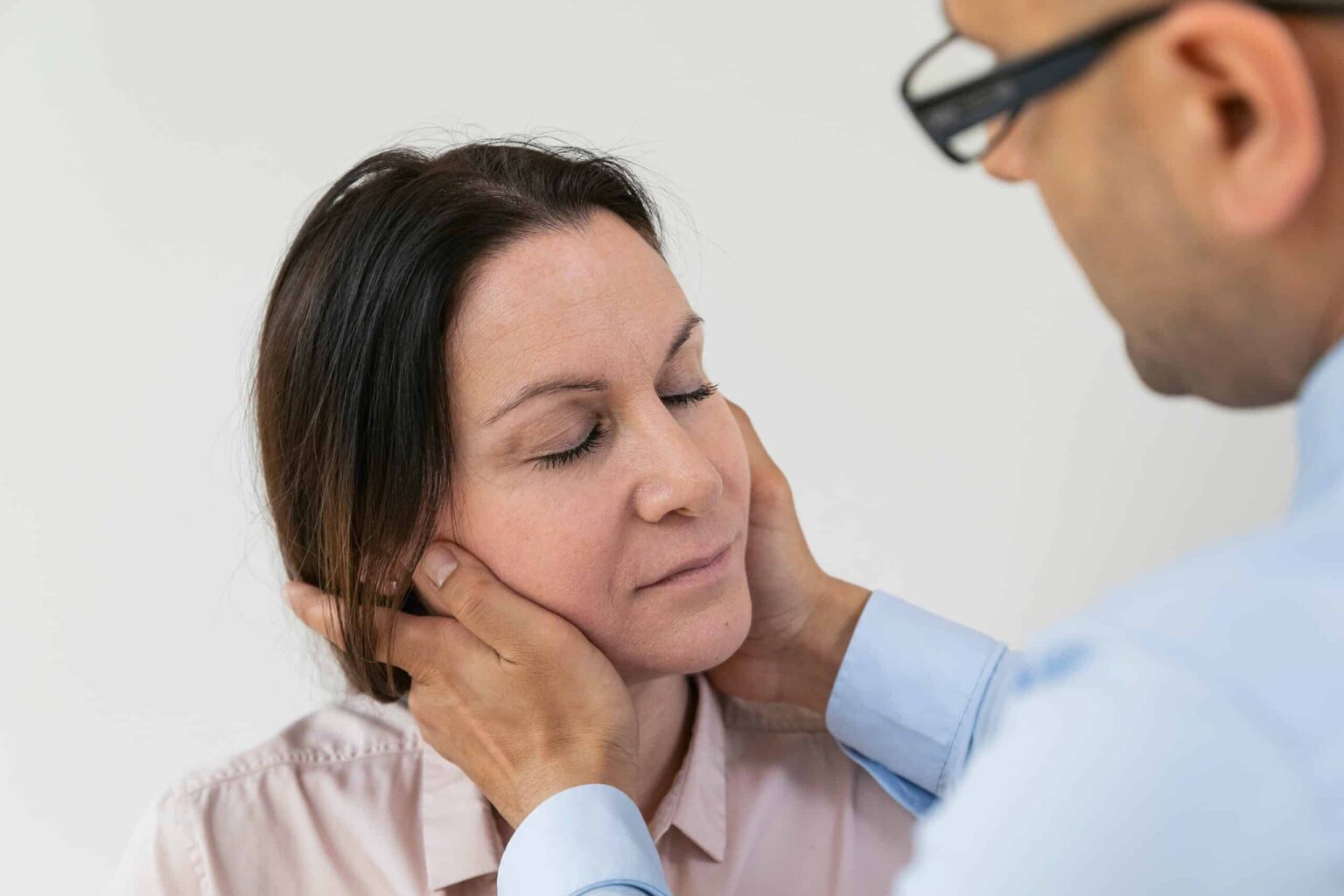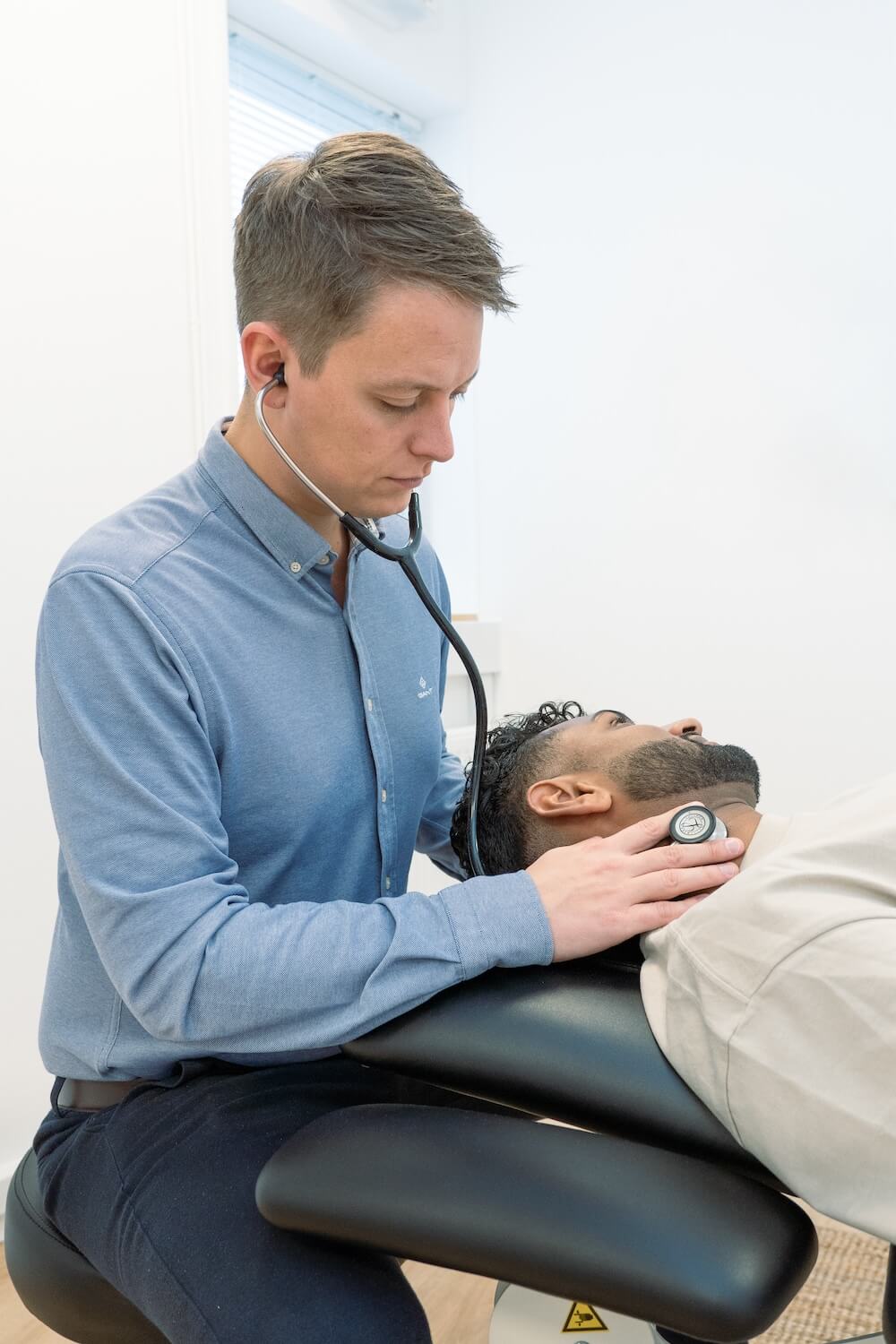We treat
Lymphedema
Learn more about lymphedema and water in the body
Lymphedema, edema and water in the body
Lymphedema and water retention in the body is a condition that is not very well-known. The condition occurs to a much greater extent than previously thought. There are no exact figures on how many people suffer chronically from edema, water retention and lymphedema.
Jump to section [Vis]
What is lymphedema, edema, and water retention?
Lymphedema is a structural or functional defect in the body’s lymphatic system where lymph fluid accumulates and forms edema (water in the body).
This means that the lymph nodes and lymphocytes do not function optimally or not at all.
The lymphatic system consists of a large network of lymphatic vessels, lymph nodes and lymph vessels whose role is to transport excess fluid (lymph) and waste products from tissues and organs back to the blood on its way to the heart.
Lymphedema can be divided into primary lymphedema and secondary lymphedema.

Primary lymphedema
Primary lymphedema is a congenital defect in the lymphatic system. At birth, patients with primary lymphedema have fewer lymph nodes and lymphatic vessels and/or the genes cause these to not develop properly. In some cases, primary lymphedema is seen in the arms, legs or head from birth. However, primary lymphedema does not appear until puberty or during the teenage years. Primary lymphedema is most often seen as fluid accumulation in the legs, but it can also occur elsewhere in the body.
Secondary lymphedema
Secondary lymphedema is not a congenital defect in the lymphatic system. Instead, an injury has been inflicted on an optimally functioning lymphatic system. These injuries are seen primarily in the form of scar tissue after surgeries or surgical removal of lymph nodes, recurrent infections of the lymphatic system, radiation damage in connection with cancer treatment, or damage caused by medications and other preparations. Secondary lymphedema responds very well to a holistic osteopathic treatment.
Chronic lymphedema
Chronic lymphedema is not a category in itself but simply edema or fluid retention that has lasted more than 3 months. Chronic lymphedema can be both primary and secondary but is most often caused by other diseases or disorders.
Lymphedema and cancer
Lymphedema is often related to cancer, as edema in the lymphatic system often occurs after surgical removal of lymph nodes or due to scar tissue that prevents the lymphatic system from draining fluid from the tissue. In many cases, lymphedema occurs in women who have received cancer treatment for either breast or pelvic cancer.
The fluid buildup can occur in the head, neck, arms, groin, or legs. Men can also get lymphedema in connection with treatment for prostate, penile, or testicular cancer.
Lymphedema and obesity
Overweight is not seen as a direct cause of lymphedema development. However, overweight is often associated with worsening of already developed lymphedema. The formation of fat in the tissue further limits the flow of lymph.
Therefore, it is always ideal to reduce excess weight and begin activities that support weight loss.

Lymphedema symptoms
As mentioned above, lymphedema is divided into four stages where the symptoms are slightly different (see section on the development of lymphedema). In general, however, symptoms such as swelling, a feeling of heaviness and fatigue, tension, discomfort, pins and needles and stiffness that develop into pain are often experienced. Water and fluid in the body (fluid retention), edema in the body is experienced, especially during menstruation, pregnancy, menopause and/or weight gain.
The skin is often dry, hard and uneven, which easily cracks and forms ulcers.
Where can lymphedema occur?
In principle, lymphedema can occur anywhere in the body. However, there are areas where lymphedema is more likely to develop due to the anatomical location of the lymph nodes and lymphatic vessels.
Edema in the hands, fluid in the arms are common as well as swollen legs, water in the groin and lymphedema in the head, face and around the eyes. Lymphedema can also occur in the abdominal region as a distended stomach and bloating, but this is less common.
Causes of lymphedema
In primary cases of lymphedema, the cause is unknown. It is believed to be genetic and something you are born with. Here, the lymphatic system is either defective from birth or does not develop properly.
Secondary lymphedema has many causes. Filariasis infection is considered the largest cause of secondary lymphedema in the world. This form is an infectious form that is transmitted from person to person by mosquitoes.
Erysipelas infections are also a common condition that can either cause or worsen secondary lymphedema.
Other common causes are scar tissue after surgery, surgical intervention where lymph nodes and lymphatic pathways have been removed, bad veins, wounds on the legs, trauma to tissue (blows and accidents), burns, complicated bone fractures and severe obesity.

Development of lymphedema
Normally, lymphedema develops in four stages.
First stage lymphedema
At this stage, fluid accumulation and edema cannot be observed. This means that there is no swelling (edema) or fluid accumulation. However, in some cases, changes can be seen on the skin and tissue in the area due to reduced transport of lymph in the lymphatic system.
Second stage lymphedema
In this stage, swelling and fluid in the tissue can be observed. Here the lymphatic system cannot compensate, which overloads the system. Symptoms such as a feeling of heaviness and fatigue associated with swelling, which are especially pronounced after physical exertion or when the weather conditions are hot. Basic measures such as raising the body part above heart level always help, as well as osteopathic lymphedema treatment.
Third stage lymphedema
Here the water in the body is almost permanent. This means that the lymphedema circulates poorly in the lymphatic system, which leads to changes in the tissue. The tissue develops with the formation of fatty tissue and fibrosis in the remaining connective tissue. Here the tissue is very hard and rigid, which often leads to recurring infections. In addition to the normal symptoms such as tension, heaviness and fatigue, pain and reduced mobility is often experienced in the lymphedema area.
The edema is firm and is characterized by a moderate or pronounced formation of fatty tissue and the beginning formation of connective tissue (fibrosis).
Fourth stage lymphedema
This stage is permanent and irreversible due to the long-term formation of fat and connective tissue. The skin is stiff, thick and cracks easily. There is a particularly high risk of infections and inflammation.
Lymphedema assessment
First and foremost, the assessment process is determined based on the patient’s anamnesis (history and interview), physical symptoms, and clinical examination in the form of a series of manual tests.
The first two phases of lymphedema development (see section Development of Lymphedema) belong to the clinic where we as osteopaths are specialists in diagnosing and treating this. The last two phases (3 and 4) can be remedied at the clinic but not permanently removed.
Diagnosis for these phases is done in hospital through a series of scans, imaging, etc. (vein scan, MRI scan, ultrasound scan, lymph scintigraphy, various blood tests and in some cases genetic diagnosis).

Lymphedema treatment and therapy
Osteonordic consists of multidisciplinary experts who have various specialist areas within the diagnosis and treatment of causes of lymphedema.
We use a special way to drain lymph in different areas of the body. Our method is based on the anatomy and physiology of the lymphatic system, which means that the osteopaths treat both the venous and lymphatic systems together. The venous system and the lymphatic system function with the help of the respiratory and muscular pump.
Osteopathy deals with manual treatment of the lymphatic channels, the organs the lymphatic system drains into (liver, heart and lungs), as well as all connective tissue and scar tissue that can help restrict lymphatic circulation.
We then educate the patient on advice regarding diet, exercise and lifestyle which improves the function of the lymphatic system.
Good advice for lymphedema, edema and fluid retention
There are many tips and methods that lymphoedema patients can use to get rid of their edema and water retention.
To avoid the development of lymphedema, it is important to change inappropriate and static working positions at work. In addition, small breaks should be planned into everyday life where physical movement is used (standing up, walking, various exercises, etc.). Intake of vitamins and minerals such as magnesium can also prevent fluid retention in some cases.
If lymphedema has already occurred, there is also good advice against swollen legs. The use of compression stockings and gloves can be used against lymphedema in stages 3 to 4. If you are overweight, permanent weight loss is very important in reducing water in the body. The most important thing in relation to lymphedema is lymphatic drainage exercises.
Osteopathic approach to lymphedema
We specialize in treating the causes of lymphedema, edema and fluid retention. We have a multidisciplinary team consisting of osteopaths, physiotherapists, massage therapists, craniosacral therapists, acupuncturists who all have unique ways of dealing with lymphedema issues in all phases.

Often related problems

Jaw joint pain

Kissing disease

Diabetes mellitus

Eye inflammation

Padel injuries

Sedentary work

Nicotine and exercise

